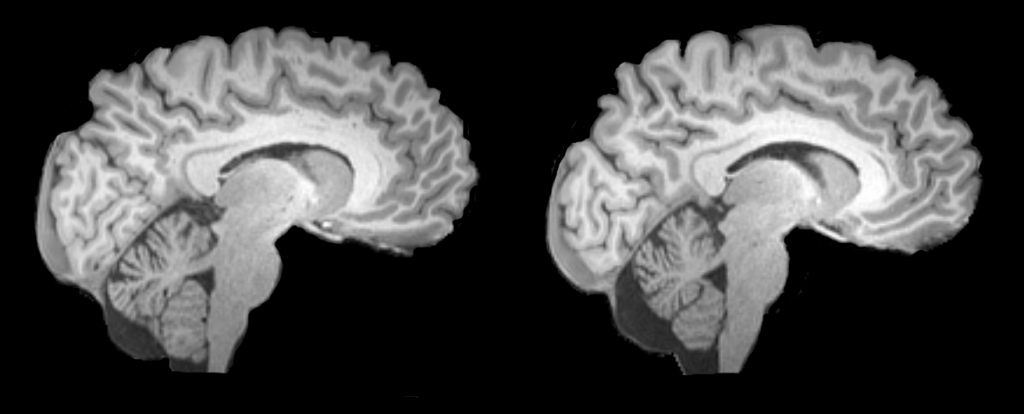This post is also available in Dutch.
We see a lot of brains in the MRI here at the Donders Institute, and in some ways they all look incredibly alike. A brain is a brain. But at the same time, every brain is entirely different from all of the others.
Brain 101
A brain consists of many different parts. I will list a few important ones here. All the way at the bottom is the brain stem. Neurons in the brain stem are in charge of basic life functions such as breathing, beating of the heart, and swallowing food. Above the brain stem sits the striatum, important for experiencing reward among other things, and the thalamus, which functions as a big central hub for incoming signals. The outside of the brain consists of the cortex, which is responsible for complex thought and computation.
You may also notice a black area, called the ventricle, in the center of the brain. This hollow area is filled with cerebral fluid, which enables the distribution of nutrients and processing of waste in addition to functioning as a shock absorber. Finally, the cerebellum can be found low down, at the back of the brain. The cerebellum is important for coordinating and adjusting movements. Without it we would not be able to walk upright!
The coiled cortex
The biggest differences between individuals are found in the cortex – the coiled, folded, outer layer of the brain. The folds allow for as much brain as possible to fit into the limited space of the skull. The cortex consists of grey matter (the cell bodies of neurons) and white matter (the connections between the neurons). As animals became smarter throughout evolution, grey matter started taking up more and more space. This caused the surface of the brain to start folding in on itself and thereby the development of wrinkles.
In this video from Harvard University you can see an experiment in which researchers let a special kind of material swell in a limited space. Without any intervention, the resulting shape looked a lot like a brain. This suggests that the brain’s folds developed much more automatically than we previously thought.
The large differences between brains also develop while the brain is in the process of folding. Thus, between brains, most folds in the same area don’t really resemble each other; similarities are only found at a global level. The brains of identical twins do look much more alike, compared to two unrelated individuals, but you can still spot differences in folding pattern.

The two brains of identical twins. Spot the differences! (Hint: the folds are different).
There are other reasons brains can differ. Our genes matter a lot, but so do our interests. Even when our brain is no longer growing, connections can change. In some studies, researchers had university students regularly practice juggling for three months. Afterwards, areas of the brain involved in controlling hand movements were measurable larger. This shows that using specific areas of our brain more intensively will trigger more development in those areas. So, you can still influence the shape of your brain!
As you can see, even if you have an identical twin, your brain is entirely unique. Also, by using your brain according to your personal preferences, your brain and you will change.

woww amazing.. the article is very useful for the readers and makes me even more interested in continuing to search for information that I don’t know